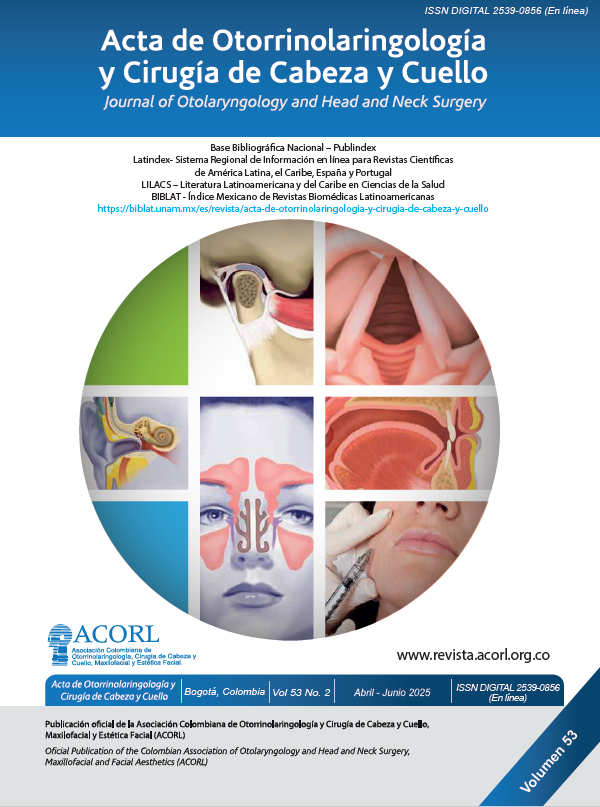Clinical characterization of invasive fungal rhinosinusitis in patients undergoing functional endoscopic surgery.
Main Article Content
Abstract
Introduction: Invasive fungal rhinosinusitis is an invasion of fungal microorganisms at the sinonasal level, which can extend to orbital and intracranial structures. It has a predilection for immunocompromised patients, being a cause of mortality in this population, which requires aggressive medical-surgical management. Objective: Identify the clinical characteristics of patients with invasive fungal rhinosinusitis due to mucormycosis who underwent functional endoscopic surgery. Methods: Retrospective cross-sectional study of patients from the Otorhinolaryngology Service with invasive fungal rhinosinusitis due to mucormycosis who underwent functional endoscopic surgery between January 1, 2015 and January 1, 2023 at the 20 de Noviembre National Medical Center in Mexico City. Results: A total of 16 patients with a diagnosis of invasive fungal rhinosinusitis were included, 7 women (43.75%) and 9 men (56.25%). The average age was 47 years; 68.75% had diabetes mellitus, 43.75% had arterial hypertension and 18.75% had acute lymphocytic leukemia. There were no surgical complications. Three patients (18.75%) presented prolonged neutropenia, 5 (31.25%) underwent enucleation and there was only one death. Conclusion: In patients with invasive fungal rhinosinusitis diagnosed with mucormycosis, the most common symptom was headache followed by nasal obstruction. The most common comorbidity was diabetes mellitus. Vascular disease, pneumonia and SARS-CoV-2 infection are statistically significantly associated with prolonged neutropenia.
Downloads
Article Details

This work is licensed under a Creative Commons Attribution-ShareAlike 4.0 International License.
Este artículo es publicado por la Revista Acta de Otorrinolaringología & Cirugía de Cabeza y Cuello.
Este es un artículo de acceso abierto, distribuido bajo los términos de la LicenciaCreativeCommons Atribución-CompartirIgual 4.0 Internacional.( http://creativecommons.org/licenses/by-sa/4.0/), que permite el uso no comercial, distribución y reproducción en cualquier medio, siempre que la obra original sea debidamente citada.
eISSN: 2539-0856
ISSN: 0120-8411
References
Fernández-Laverde M, et al. Urgencias hemato-oncológicas. Manual de la Sociedad Latinoamericana de Cuidados Intensivos Pediatricos (SLACIP). Disponible en: https://slacip.org/manual-slacip/descargas/SECCION-13/13.1-Urgencias%20OncologicasFinal.pdf
Mendoza-Sánchez M, Riesco-Riesco S, González-Prieto A. Unidad de Hematología y Oncología Infantil. Urgencias oncológicas en Pediatría M.C. Complejo Asistencial Universitario de Salamanca. Pediatr Integral. 2019;23(2):65–80.
Vargas P, Lautaro. Cáncer en pediatría: Aspectos generales. Revista chilena de pediatría. 2000;71(4):283-295. doi: 10.4067/S0370-41062000000400002
Place R, Lagoc AT, Mayer TA, Lawlor CJ. Urgencias oncológicas y hematológicas en niños. En: Tintinalli JE, Stapczynski J, Ma O, Cline DM, Meckler GD, Cydulka RK. (editores). Tintinalli. Medicina de urgencias. 7.a edición. McGraw-Hill Education;2013.
Evangelista MS, Molina A, Della Corte M, Fraquelli L, Bonifacio P. Urgencias en pacientes oncológicos pediátricos. Arch. Pediatr. Urug. 2016 ; 87(4):359-373.
Park AH, Muntz HR, Smith ME, Afify Z, Pysher T, Pavia A. Pediatric invasive fungal rhinosinusitis in immunocompromised children with cancer. Otolaryngol Head Neck Surg.2005;133(3):411-6. doi: 10.1016/j.otohns.2005.04.014.
Hanba C, Svider PF, Lai W, Raza SN, Sheyn A, Eloy JA, Folbe AJ. An investigation of operative outcomes: Pediatric invasive fungal sinusitis. Int J Pediatr Otorhinolaryngol. 2017;102:142-
doi: 10.1016/j.ijporl.2017.09.009
Ramírez Argueta JJ, Díaz Molina JP, Ortiz Oliva RJ, Carlos Bregni R, Bustamante Y. Results of endoscopic nasal surgery in the treatment of invasive fungal sinusitis in children with cancer and immunosuppression. Acta Otorrinolaringol Esp (Engl Ed). 2019;70(6):348-357. English, Spanish. doi: 10.1016/j.otorri.2018.09.001
Vinh D, Yim M, Dutta A, Jones JK, Zhang W, Sitton M. Pediatric invasive fungal rhinosinusitis: An investigation of 17 patients. Int J Pediatr Otorhinolaryngol. 2017;99:111-116. doi: 10.1016/j.ijporl.2017.05.015
Ergun O, Tahir E, Kuscu O, Ozgen B, Yilmaz T. Acute Invasive Fungal Rhinosinusitis: Presentation of 19 Cases, Review of the Literature, and a New Classification System. J Oral Maxillofac Surg. 2017;75(4):767.e1-767.e9. doi: 10.1016/j.joms.2016.11.004
Roehm C, Salazar J, Hagstrom N, Valdez T. Phoma and Acremonium invasive fungal rhinosinusitis in congenital acute lymphocytic leukemia and literature review. International Journal Of Pediatric Otorhinolaryngology. 2012;76(10):13871391.doi:10.1016/j.ijporl.2012.06.026
Smith A, Thimmappa V, Shepherd B, Ray M, Sheyn A, Thompson J. Invasive fungal sinusitis in the pediatric population: Systematic review with quantitative synthesis of the literature. Int J Pediatr Otorhinolaryngol. 2016;90:231-235. doi: 10.1016/j.ijporl.2016.09.019
Epstein VA, Kern RC. Invasive fungal sinusitis and complications of rhinosinusitis. Otolaryngol Clin North Am. 2008;41(3):497-524, viii. doi: 10.1016/j.otc.2008.01.001
Davis K, Wilson S. Febrile neutropenia in paediatric oncology. Paediatr Child Health (Oxford). 2020;30(3):93-97. doi: 10.1016/j.paed.2019.12.002.
Abdulrhman MA, Hamed AA, Mohamed SA, Hassanen NA. Effect of honey on febrile neutropenia in children with acute lymphoblastic leukemia: A randomized crossover open-labeled study. Complement Ther Med. 2016;25:98-103. doi: 10.1016/j. ctim.2016.01.009.
Barton CD, Waugh LK, Nielsen MJ, Paulus S. Febrile neutropenia in children treated for malignancy. J Infect. 2015;71 Suppl 1:S27-35. doi: 10.1016/j.jinf.2015.04.026

